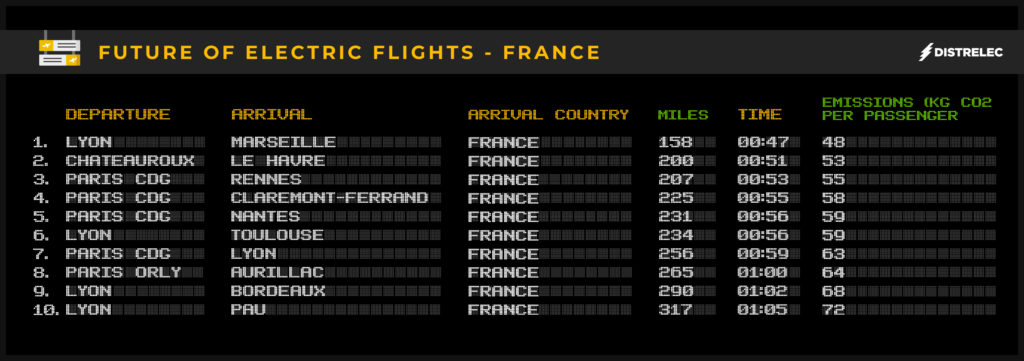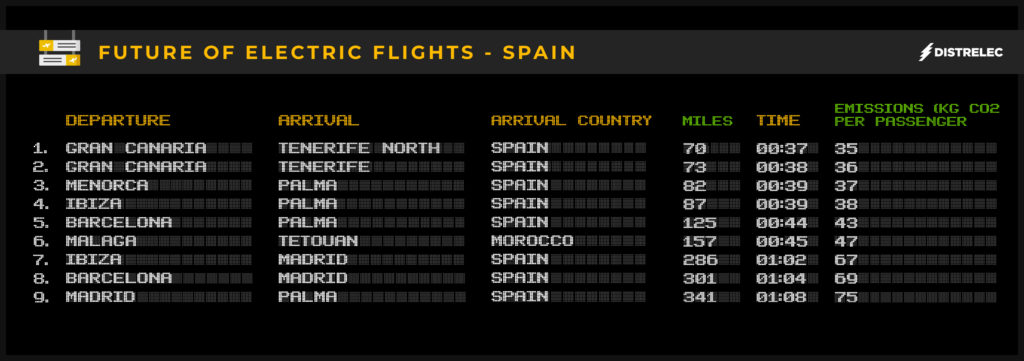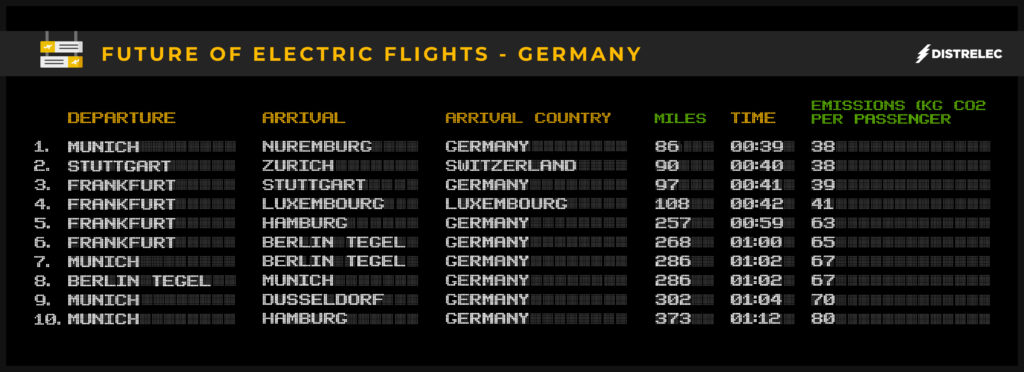In 2019 Airbus, a European aerospace company, forecast that the global use of airline flights was expected to double over the course of the next 20 years. However, with electric planes being close to a commercial breakthrough, the future of travel could look very different.
Reports show that electric planes can currently travel for up to 90 minutes on a single charge. With this in mind and half of all global flights reportedly totalling under 500 miles, there is huge potential to reduce the environmental impact that flying has on our planet.
While we know that current electric air travel is limited to smaller planes flying for 90 minutes, Distrelec are predicting what the future of commercial air travel could look like based on this data. It was reported in 2020 that electric commercial air travel was getting closer to a breakthrough and it has been estimated that by 2025 the aviation industry will be 25% electric or hybrid. This transformation of the industry will see a big change in the emissions and carbon footprint. For the UK alone in 2019 there were just under 40 million domestic passenger movements and at an average of 67kg Co2 this could save an estimate of nearly 2.7 million tonnes Co2 in UK domestic flights alone.
By taking a look at the most popular short-haul flights across Europe, we have identified the flight routes that are most likely to be adapted to be fully electric in the future.

Flights Departing from the UK

Of over 100 flights analysed throughout our study, 24 depart from various areas across the United Kingdom; the shortest being a flight from Belfast International to the Isle of Man taking on average 38 minutes and emits 36kg of Co2 per passenger onboard the 76-mile flight. In 2019, 19,808 passengers used this flight meaning with the introduction of electric flights an incredible 752 tonnes Co2 could be saved.
Longer domestic flights across the UK include London Gatwick to Edinburgh, London Gatwick to Glasgow, and London Heathrow to Aberdeen, the longest of which takes 1 hour and 15 minutes, currently emitting a total of 84kg of Co2 per passenger on board.
Mini-breaks between London and Dublin are common for many UK nationals, with flights lasting just over an hour. The 280-mile trip from Dublin Airport to London Heathrow places the journey well within consideration for the switch to electric in the future.
At 181 miles, a flight from London Southend to Amsterdam takes on average 50 minutes, putting the route within the running to be one of the first all-electric flights to depart in the UK and land outside of it. Three flights from the Netherlands are also included, all of which depart from Amsterdam.
Other international flights include London Heathrow to Amsterdam, Paris, Antwerp and Cologne. Antwerp and Paris share in their accessibility being only a 54 minute flight totalling 57kg Co2 per person. The 333 mile flight to Cologne is slightly longer at 67 minutes with a total of 74kg Co2 per person.
Not included in our table is the flight from Orkney Islands of Westray and arriving in Papa Westray. At 1.7 miles, the duration of the flight is just 1 minute, and the emissions currently amount to 4kg of Co2 per passenger. This flight is the world’s shortest commercial flight and the perfect candidate for electric travel due to length and amount of passengers per year being low. This flight is mainly used by the 90 residents, healthcare professionals and students when they visit to study the 60 archealogical sites.
Flights Departing from France

Aura Aero, an aerospace company born in Toulouse, recently unveiled a 19-seat electric aircraft development plan in a bid to “create an airline-airport coalition for low-carbon aviation.” Taking a look at the most popular short-haul flights across the country, we were able to locate a possible 36 domestic flights as contenders to make the first shift to electric aviation in France.
The shortest of the flights is from Lyon to Marseille. At a total of 158 miles, the journey takes approximately 47 minutes and currently emits an average of 48kg of Co2 per person throughout the duration of the flight. Based on as assumption that all of the 148 passenger seats are filled on an Air France flight for the total 171 flights, then a staggering 1,200 tonnes Co2 could be saved by making this flight electric. Another popular journey within the 500-mile range limit departs from Lyon to Toulouse and is approximately 234 miles.
Ten flights within our study depart from the largest international airport in France, Paris Charles de Gaulle (PCG) and arrive in the likes of Rennes, Nantes, Lyon, Bordeaux and Marseille with flights ranging from 207 to 430 miles. Even before the arrival of electric flights, France is making steps to reduce carbon footprint of domestic flights by voting in favour of banning short domestic flights where train alternatives exist.
Flights Departing from Spain

Lilium GmbH, a German aerospace company responsible for the eVTOL jet, announced in April that test flights using the Pheonix 2 had begun in Spain. Throughout our study, 9 potential flights were recorded departing from areas such as Gran Canaria, Menorca, Ibiza, Barcelona, Malaga and Madrid due to being within the 500-mile limit and therefore among the most likely to turn electric.
Flights Departing from Germany

In a press release from May, Airbus announced the formation of the Air Mobility Initiative (AMI); a movement created to contribute to the development of advanced air mobility. Involved within this organisation are Airbus, City of Ingolstadt, Deutsche Bahn, Deutsche Flugsicherung, Diehl Aerospace, Droniq, Munich Airport, Red Cross, and Telekom with the initiative supported by the Federal Republic of Germany.
The majority of flights from Germany included in our study depart from Frankfurt and Munich, with journeys ranging from 86 to 497 miles. Among the longest flights considered for electric aviation was the journey from Frankfurt to London Heathrow, taking on average 1 hour and 16 minutes and currently emitting 85kg of Co2 for every passenger on board.
Domestic German flight routes are some of the busiest within Germany with their busiest being from Frankfurt to Berlin Tegel. Approximately 2,292,098 people use this flight annually, these figures estimate a saving of nearly 150,000 tonnes Co2.
The only journey departing in Stuttgart arrives in Zurich, Switzerland, and is a 90-mile journey arriving at the destination within 40 minutes.
Flights Departing from Italy
Just three flights departing from Italy were within the 500-mile limit, including Comiso to Malta, Catania to Malta, and Milan Malpensa to Zurich. These flights range from 72 to 127 miles, with the longest emitting 44kg of Co2 for each passenger.
Additional European Flights
Both Denmark and Sweden have recently announced plans to make all domestic flights fossil fuel-free by 2030. Our findings located three flights departing from Stockholm, arriving in Oslo, Helsinki and Copenhagen all within the 500-mile limit for an electric flight, whilst the 92-mile route from Aarhus to Copenhagen could also find itself considered in Denmark.
Why is Electric Aviation Taking Off?
Described before as an “inevitable shift”, aviation is predicted to follow in the footsteps of the automotive world; relying on battery-generated electricity for power instead of fuel alternatives.
According to data from Statista, CO2 emissions produced by commercial aviation declined considerably to 495 million metric tons in 2020 in comparison to its pre-pandemic figure of 936 million. However, as of May 2022, that figure is set to surpass those reported in 2020 and 2021, rising to a predicted 671 million from flights conducted just this year.
Originally announced by the United Nations in October 2020, a net-zero carbon emissions deadline was set for 2050. With this news, airlines across Europe and the rest of the world signed an agreement to meet that target. According to an article by Forbes, American airline manufacturer Boeing has estimated that with technology developing as it is, smaller electric planes may be available as soon as the 2030s.
—————————————————————————————————————————
Methodology
Flight data was taken from OAG (Official Airline Guide), Air Miles Calculator was used to calculate miles and emission data. Source for length of electric flights was based on the Pipstrel Alpha Electro.










